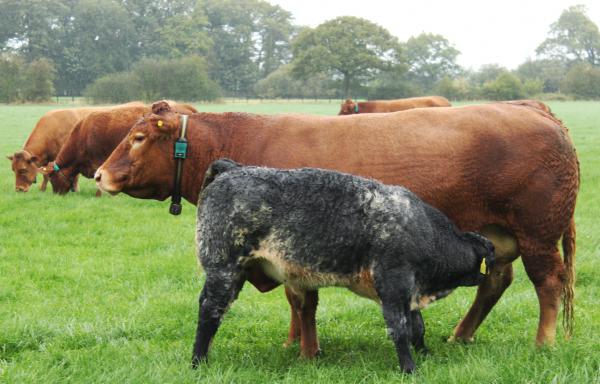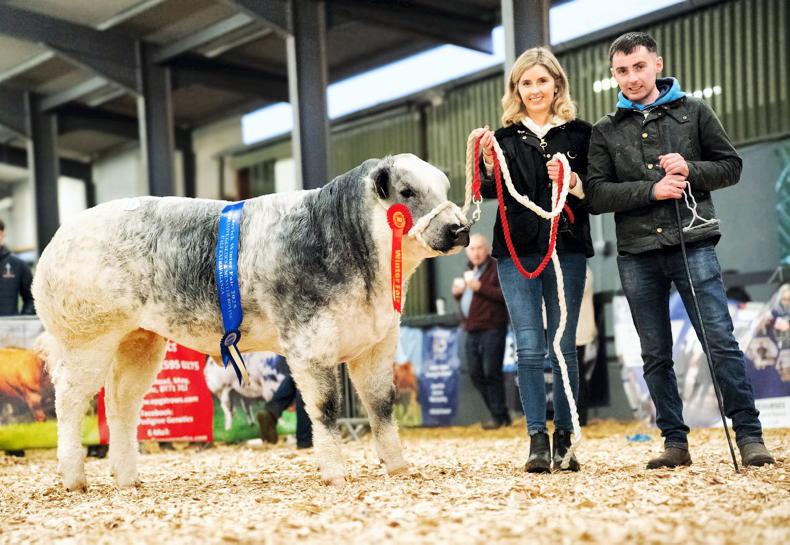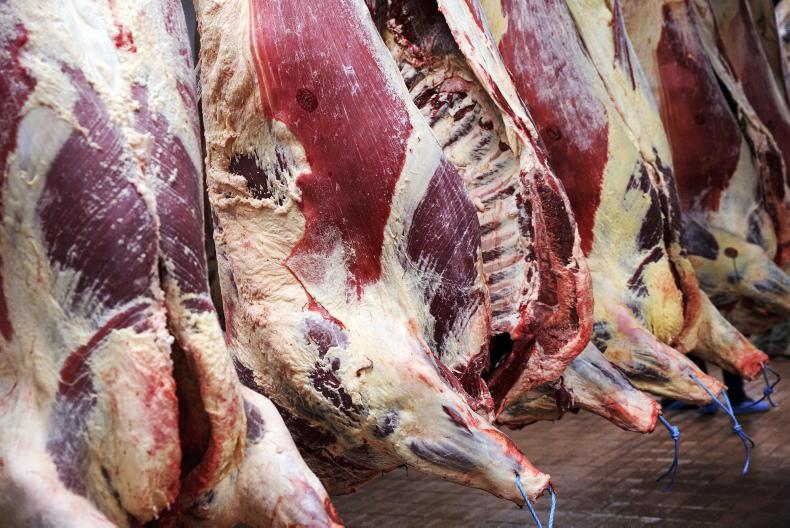With the new genomic herd reports being issued by ICBF, there was plenty of discussion centred on breeding at the Iivestock demo at the Ploughing this week. Farmers were keen to get to the bottom of why some cows move up in maternal index and why some move in the opposite
direction.
Maternal breeding is definitely an area that suckler farmers are interested in. Some farmers are looking to increase the number of breeding cows in their herds with four- and five-star ratings to meet the requirements of BDGP. Equally, there are plenty of suckler farmers who are not part of BDGP but are still keen to change their breeding programme and produce cows with greater maternal characteristics. Milk, mature cow size, longevity and an easier maintained cow came up in several conversations from numerous farmers across the country.
While keen to improve cow type, there is reluctance from some herdowners to go completely down the maternal breeding route. The main reason is that using maternal bulls will affect calf quality. While it is a valid concern, especially for suckler farmers selling weanlings, there are more and more maternal bulls coming on to the market with high maternal and terminal genetics with proven breeding ability.
The key thing when selecting any bull based on star ratings is to pay attention to the accuracy level of the bull. Young stock bulls will have lower accuracy ratings as they have no progeny on the ground. But with genotyping, accuracy levels on a young stock bull can be increased by as much as 50% if it is bred from proven bloodlines.
Selecting potential herd sires based on high maternal ratings and high accuracy levels will deliver calves on the ground that are suitable for breeding, but will still meet the requirements of the live or finishing trade.
Selecting the right heifer
When choosing heifer replacements, using the genomic data available will help you to make a more informed decision. Do not rule out keeping heifers with lower star ratings as these animals can still produce a high star-rated calf if crossed with the right sire. During the livestock demo at the Ploughing, three very different beef heifers were on display and the breeding options were discussed at length. The group of three consisted of a Parthenaise cross (maternal index: €144), a Shorthorn cross (maternal index: €84) and an Angus cross Friesian (maternal index: €73). The Parthenaise and Shorthorn animals have been genotyped but the Angus heifer has not, which is the main reason for the lower maternal index value.
Once genotyped, the maternal index of this animal will increase as it has 50% dairy breeding. The Parthenaise heifer had a reduction in maternal value after it was genotyped, while the Shorthorn heifer’s maternal index increased based on the amount of maternal genetics it inherited from its dam. Both the Shorthorn and Angus heifers would make good breeding cows for most herds as they could easily be mated to bulls with strong terminal traits.
Crossing the Shorthorn heifer with a proven maternal bull will deliver highly rated progeny that could be retained for breeding or sold with breeding potential. Options for the Parthenaise heifer were more limited, given that she possessed strong muscling characteristics. While she has some dairy breeding in her background, which is partly the basis of the high maternal rating, the animal would have to be served with easy-calving sires to avoid calving difficulty.
Most farmers agreed that if managed correctly, she would be suitable for producing high-valued weanlings for the shipping trade.
Maternal genetics
When making breeding decisions for your suckler herd, is cow longevity something that you factor in? Management will play a big part in how long a cow will breed before culling. But so to, does the animal’s genetics. This does not mean that every cow should be going down the native breed route.
Rather, it is more about selecting the right type of breeding lines that will produce functional cows to suit your farm and the market you sell into. Breeding a more robust, functional cow that will suit our grass-based systems should be a key consideration when selecting a new herd sire or when choosing replacement heifers. Repeatedly selecting herd sires and breeding cows based solely on terminal traits have increased the size of suckler cows in Ireland.
In many instances, selecting for growth and muscling (conformation) has reduced the milk production in the suckler cow also. Bigger cows can become a burden on suckler farmers as they require a greater grazing area to keep them and can do serious ground damage when conditions are wet. Larger cows have a higher feed requirement and if not fed correctly, the cow’s fertility and milk will suffer. This is a leading reason why so many cows are culled at a young age.
Roughly speaking, it takes an extra 0.5t of silage per month for every additional 100kg of cow liveweight. Therefore, if your average cow liveweight is 750kg, a cow at 850kg will eat an extra 3t of silage over a six-month winter. At €25/t, that equates to an extra €75/cow in feed costs. A 2002-born Belgian Blue cross suckler cow was part of the demo. The cow is bred from maternal lines and calved down for the first time at 26 months of age. The cow has produced 12 calves to date and is due to calve again in January 2017 with a calving interval around 365 days.
The animal has a replacement index of €103 and is five stars for maternal traits. At a mature liveweight of 620kg, she is weaning close to 50% of her liveweight every year. Cow body condition is ideal for late autumn and shows the value of breeding a moderately sized cow that is capable of gaining and holding condition at grass, while suckling a calf. With her calf now weighing 300kg, weaning this cow and placing her on to a maintenance diet of grass, or silage, will reduce the winter feeding costs associated with keeping the suckler cow.
Producing more functional cows with greater milking ability will increase calf weaning weight from grass rather than meal. Under good farm management, these cattle can be taken through to slaughter at a younger age but still at acceptable carcase weight on lower inputs. Breeding is a long-term goal. It is easy to become discouraged over changing cow type or breed type if you do not see results immediately.Using genotyped bulls with high accuracy levels will deliver the type of cow you are aiming for – you just have to have faith and stick with it.Two steers born in April 2015 and part of a feed trial at Tully were present. Both animals are bred from the same sire (LZZ), yet there is almost 100kg of a liveweight differential between the two animals. Both animals are of good quality and very saleable in the live trade at present.
At 500kg, the lighter animal is unlikely to finish out of the shed next spring. Instead, this animal would most likely be put back to grass and killed next summer on a normal farm.
The other animal is on track to kill out at 22 months of age. The current liveweight is 600kg, so after a 100-day finishing period, this steer could produce a 390kg to 400kg carcase and killed around eight months earlier than the lighter steer.
The two animals show that management on farm will play a bigger part in the performance of cattle than the influence of terminal or maternal sires.
Of course, cow type has to be remembered also but in this case, both animals were bred from Charolais cross cows. Being able to finish cattle at a younger age and at carcase weights meeting market spec will be a much more profitable system to operate for suckler farmers.
With the new genomic herd reports being issued by ICBF, there was plenty of discussion centred on breeding at the Iivestock demo at the Ploughing this week. Farmers were keen to get to the bottom of why some cows move up in maternal index and why some move in the opposite
direction.
Maternal breeding is definitely an area that suckler farmers are interested in. Some farmers are looking to increase the number of breeding cows in their herds with four- and five-star ratings to meet the requirements of BDGP. Equally, there are plenty of suckler farmers who are not part of BDGP but are still keen to change their breeding programme and produce cows with greater maternal characteristics. Milk, mature cow size, longevity and an easier maintained cow came up in several conversations from numerous farmers across the country.
While keen to improve cow type, there is reluctance from some herdowners to go completely down the maternal breeding route. The main reason is that using maternal bulls will affect calf quality. While it is a valid concern, especially for suckler farmers selling weanlings, there are more and more maternal bulls coming on to the market with high maternal and terminal genetics with proven breeding ability.
The key thing when selecting any bull based on star ratings is to pay attention to the accuracy level of the bull. Young stock bulls will have lower accuracy ratings as they have no progeny on the ground. But with genotyping, accuracy levels on a young stock bull can be increased by as much as 50% if it is bred from proven bloodlines.
Selecting potential herd sires based on high maternal ratings and high accuracy levels will deliver calves on the ground that are suitable for breeding, but will still meet the requirements of the live or finishing trade.
Selecting the right heifer
When choosing heifer replacements, using the genomic data available will help you to make a more informed decision. Do not rule out keeping heifers with lower star ratings as these animals can still produce a high star-rated calf if crossed with the right sire. During the livestock demo at the Ploughing, three very different beef heifers were on display and the breeding options were discussed at length. The group of three consisted of a Parthenaise cross (maternal index: €144), a Shorthorn cross (maternal index: €84) and an Angus cross Friesian (maternal index: €73). The Parthenaise and Shorthorn animals have been genotyped but the Angus heifer has not, which is the main reason for the lower maternal index value.
Once genotyped, the maternal index of this animal will increase as it has 50% dairy breeding. The Parthenaise heifer had a reduction in maternal value after it was genotyped, while the Shorthorn heifer’s maternal index increased based on the amount of maternal genetics it inherited from its dam. Both the Shorthorn and Angus heifers would make good breeding cows for most herds as they could easily be mated to bulls with strong terminal traits.
Crossing the Shorthorn heifer with a proven maternal bull will deliver highly rated progeny that could be retained for breeding or sold with breeding potential. Options for the Parthenaise heifer were more limited, given that she possessed strong muscling characteristics. While she has some dairy breeding in her background, which is partly the basis of the high maternal rating, the animal would have to be served with easy-calving sires to avoid calving difficulty.
Most farmers agreed that if managed correctly, she would be suitable for producing high-valued weanlings for the shipping trade.
Maternal genetics
When making breeding decisions for your suckler herd, is cow longevity something that you factor in? Management will play a big part in how long a cow will breed before culling. But so to, does the animal’s genetics. This does not mean that every cow should be going down the native breed route.
Rather, it is more about selecting the right type of breeding lines that will produce functional cows to suit your farm and the market you sell into. Breeding a more robust, functional cow that will suit our grass-based systems should be a key consideration when selecting a new herd sire or when choosing replacement heifers. Repeatedly selecting herd sires and breeding cows based solely on terminal traits have increased the size of suckler cows in Ireland.
In many instances, selecting for growth and muscling (conformation) has reduced the milk production in the suckler cow also. Bigger cows can become a burden on suckler farmers as they require a greater grazing area to keep them and can do serious ground damage when conditions are wet. Larger cows have a higher feed requirement and if not fed correctly, the cow’s fertility and milk will suffer. This is a leading reason why so many cows are culled at a young age.
Roughly speaking, it takes an extra 0.5t of silage per month for every additional 100kg of cow liveweight. Therefore, if your average cow liveweight is 750kg, a cow at 850kg will eat an extra 3t of silage over a six-month winter. At €25/t, that equates to an extra €75/cow in feed costs. A 2002-born Belgian Blue cross suckler cow was part of the demo. The cow is bred from maternal lines and calved down for the first time at 26 months of age. The cow has produced 12 calves to date and is due to calve again in January 2017 with a calving interval around 365 days.
The animal has a replacement index of €103 and is five stars for maternal traits. At a mature liveweight of 620kg, she is weaning close to 50% of her liveweight every year. Cow body condition is ideal for late autumn and shows the value of breeding a moderately sized cow that is capable of gaining and holding condition at grass, while suckling a calf. With her calf now weighing 300kg, weaning this cow and placing her on to a maintenance diet of grass, or silage, will reduce the winter feeding costs associated with keeping the suckler cow.
Producing more functional cows with greater milking ability will increase calf weaning weight from grass rather than meal. Under good farm management, these cattle can be taken through to slaughter at a younger age but still at acceptable carcase weight on lower inputs. Breeding is a long-term goal. It is easy to become discouraged over changing cow type or breed type if you do not see results immediately.Using genotyped bulls with high accuracy levels will deliver the type of cow you are aiming for – you just have to have faith and stick with it.Two steers born in April 2015 and part of a feed trial at Tully were present. Both animals are bred from the same sire (LZZ), yet there is almost 100kg of a liveweight differential between the two animals. Both animals are of good quality and very saleable in the live trade at present.
At 500kg, the lighter animal is unlikely to finish out of the shed next spring. Instead, this animal would most likely be put back to grass and killed next summer on a normal farm.
The other animal is on track to kill out at 22 months of age. The current liveweight is 600kg, so after a 100-day finishing period, this steer could produce a 390kg to 400kg carcase and killed around eight months earlier than the lighter steer.
The two animals show that management on farm will play a bigger part in the performance of cattle than the influence of terminal or maternal sires.
Of course, cow type has to be remembered also but in this case, both animals were bred from Charolais cross cows. Being able to finish cattle at a younger age and at carcase weights meeting market spec will be a much more profitable system to operate for suckler farmers.











SHARING OPTIONS